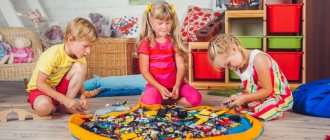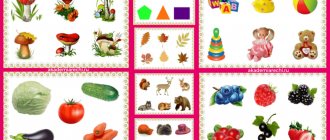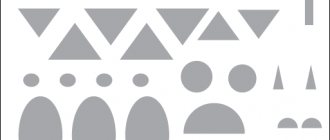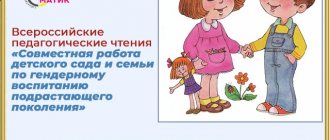Card index of games for design classes
In design classes, you can also use game moments related to the general topic. Here are some interesting games.
"Who is faster"
This game is used in a lesson with building materials on the topic “Build according to plan.” The teacher prepares either one large diagram of the proposed construction or several small ones - according to the number of teams. You also need to prepare identical building kits (you can with extra parts, but this is a more complicated option).
The guys are divided into 2-3 teams (depending on the total number of children). At the teacher’s signal, they begin to build their models. When evaluating the results, it is not only which team finished the construction first that is assessed, but also the quality of the construction - its stability, compliance with the plan and aesthetics. It is also necessary to take into account the cohesion of actions - according to the conditions of the game, a team cannot win if not all of its members took part in the game.
This game develops attentiveness, coordination, accuracy, responsibility, and the ability to work together.
"What's in the bag"
For this game you will need various parts from a wooden construction set and an opaque bag. It develops the child’s tactile sensations and helps them learn to use them. Also, the goal of the game is to consolidate the names of the building elements of the constructor.
Various parts of the construction set are placed in a bag. Children take turns putting their hand in there, taking the part and trying to determine by touch what it is. Then they name what they got, take it out of the bag and show it to everyone. The one who correctly guesses the most details wins.
"Put the parts in order"
Children are given parts from a wooden construction set. The teacher shows pictures of 6 parts for a few seconds, then removes them, and the children must put in a row the correct sequence of what they saw. This exercise perfectly develops attentiveness and memory.
You can start with 4 single-color parts, and over time reach 7 and different colors. Ideally, a child should remember a sequence of 7 objects, but 6 is considered a good result.
"Build from memory"
The game is similar to the previous one. Only here the teacher builds some kind of structure from 7-8 parts, offers to memorize it, takes it apart, and the children build from memory. Whoever builds first and correctly leads, that is, creates his own design and offers to repeat it.
"Build with your eyes closed"
A very fun game. Children are divided into teams (3-4 people will be enough so as not to interfere with each other), they are given cubes (it is better to use large plastic sets), given time to confer, then they are blindfolded and asked to build what they have in mind. The team whose construction turns out to be more interesting wins.
The game develops attentiveness, fine motor skills, accuracy, the ability to negotiate, plan and act together.
Theoretical aspects of training
Paper construction (paper-plastic) is a type of activity for preschoolers that involves:
- drawing up an action plan;
- selection of materials for crafts;
- performing manipulations using the chosen technique.
In kindergarten, children construct crafts in classes organized by the teacher in a playful way.
Lesson objectives
Before planning a lesson, the teacher must set a goal that he wants to achieve. It is implemented through several tasks.
Educational objectives:
- introduce the properties of different types of paper (classic, velvet, holographic, crepe);
- develop the ability to cut out the necessary parts for a craft and name them (square, circle, etc.);
- clarify ideas about colors and their names;
- learn to make three-dimensional shapes from paper blanks by bending, crumpling, twisting or tearing them;
- encourage the creation of products according to plan (independently choose the theme and material for the craft);
- learn to combine elements into a composition (for example, roads and houses are a street).
Correction and development tasks:
- develop fine motor skills, thinking, attention and memory;
- improve visual and tactile perception;
- develop the ability to analyze created crafts and, based on this, plan your further actions;
- develop imagination.
Educational tasks:
- develop the ability to maintain order in the workplace and put tools in their place after finishing work;
- cultivate kindness, love of nature, etc. (depending on the craft).
Types of paper designs
Paper plastic is divided into 2 types:
- origami - folding figures by bending paper;
- volumetric paper and cardboard modeling, involving the use of scissors and glue.
Design forms
There are 7 forms of organizing constructive activities:
- Pattern design developed by F. Fröble. The teacher’s actions serve as an example. Children repeat what is shown, learning new techniques for working with various materials.
- Model design proposed by A. N. Mirenov. Instead of a sample, a model is used in classes - a ready-made craft. The method for creating the product is not shown. Students must recreate the model themselves. This form of organizing activities is used when working with children 5-6 years old and older. It helps to activate the thinking of preschoolers, because... they need to mentally disassemble the product into its components and reproduce the procedure unknown to them.
- Design according to conditions, developed by N. N. Poddyakov. He suggested not giving children ready-made samples and ways to solve a problem. The underlying conditions must be problematic in nature. For example, students are asked to make an object out of paper that can be given to their mother on March 8th. This method allows you to develop thinking and imagination. It is used if children have already made given objects or analyzed products that are similar in structure.
- Design based on drawings and visual diagrams. The authors of the method are S. Leon Lorenzo and V. V. Kholmovskaya. When working with preschoolers, templates are used. Children learn to use drawings as a way of understanding an object and how to create it.
- Design by design. For kindergarten students, this activity is difficult. In order for them to think creatively, the teacher must form in children an idea of the objects being created, the ability to repeat the teacher’s actions and look for new ways to create crafts. Only after preschoolers have mastered the existing methods of paper modeling will they be able to creatively use the knowledge they have acquired.
- Design on the topic. This form is close to making crafts by design. The difference is that the teacher limits the idea to the topic. For example, a teacher invites children to create any craft on the theme “Autumn.”
- Frame design proposed by N. N. Poddyakov. This method is rarely used when working with preschoolers. The teacher shows a frame made of any material, and then does something that changes the structure. With such training, children learn not only the structure of the frame, but also how to change it.
Disadvantages of design in preschoolers
Through systematic, well-organized activities, children overcome the following shortcomings of their personal design attempts:
- the child’s plan is unclear, the structure of the image is also blurred;
- the design tends to be unstable (preschoolers begin to construct one object, but as a result they create another and are happy with it);
- excessive haste and enthusiasm for the activity itself, which distracts from the overall intent of the activity;
- vague ideas about the sequence in which actions should be performed and how they should be planned;
- Children do not know how to pre-analyze the task at hand.
If these shortcomings are not overcome, then the child will continue to engage in construction at a very low level.
Preschoolers can take part in two types of design: artistic design and technical design.
Motivation for children
To make it interesting for preschoolers, you can turn the activity into a game: bring a toy (hero) and invite the children to make a house or a gift for him.
It is important that children understand the practical significance of their activities. They will be more motivated if they know that their product can be given to an adult (mom, dad, grandmother, etc.).





